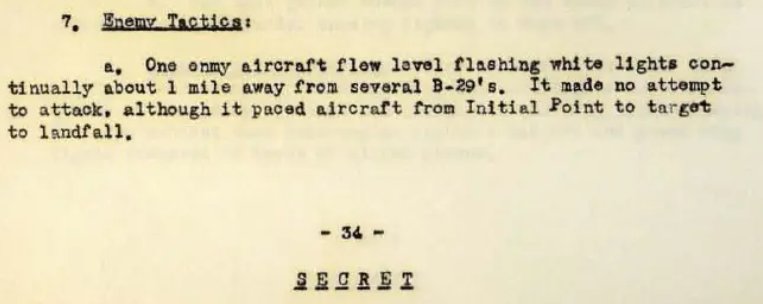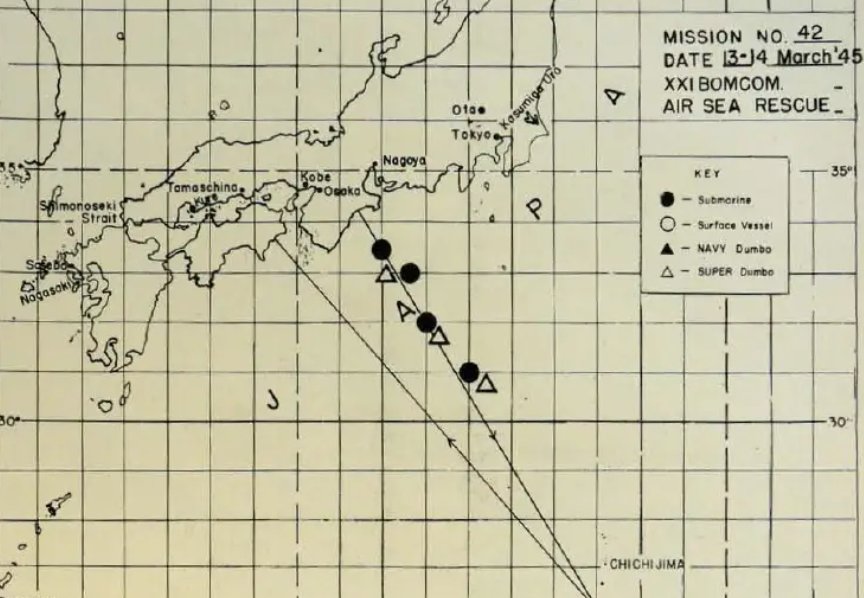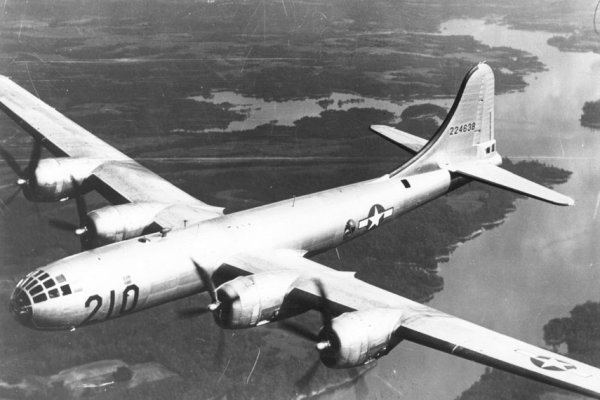ACUFO-1945-03-13-OSAKA-1
The Tactical Report of Mission 42 documented a bombing raid on Osaka, Japan, on the night of March 13-14, 1945, with the 73rd, 313th and 314th Bombardment Wings.
The mission's B-29 bombers had gathered near Chichi Jima, came inland at the eastern tip of Shikoku, were flying at a planned speed of 250 mph and altitudes between 5,000 and 6,800 feet.
The first takeoff took place on March 13, 1945 at 4:48 p.m. local time; the last landing took place on March 14, 1945 at 09:40 a.m. local time.
In the “Enemy Tactics” section of the report, it was noted:
a. One enemy aircraft flew level flashing white lights continually about 1 mile away from several B-29's. It made no attempt to attack, although it paced the aircraft from Initial Point to target to landfall.
| Date: | March 13, 1945 |
|---|---|
| Time: | Night. |
| Duration: | 30 minutes or more. |
| First known report date: | April 17, 1945 |
| Reporting delay: | Hours, weeks. |
| Country: | Japan |
|---|---|
| State/Department: | Kansai |
| City or place: | Osaka |
| Number of alleged witnesses: | Numerous. |
|---|---|
| Number of known witnesses: | Several. |
| Number of named witnesses: | 0 |
| Reporting channel: | Military Intelligence summary report. |
|---|---|
| Visibility conditions: | Night. |
| UFO observed: | Yes. |
| UFO arrival observed: | ? |
| UFO departure observed: | ? |
| UFO action: | Followed. |
| Witnesses action: | |
| Photographs: | No. |
| Sketch(s) by witness(es): | No. |
| Sketch(es) approved by witness(es): | No. |
| Witness(es) feelings: | ? |
| Witnesses interpretation: | Enemy aircraft. |
| Sensors: |
[X] Visual: Numerous.
[ ] Airborne radar: [ ] Directional ground radar: [ ] Height finder ground radar: [ ] Photo: [ ] Film/video: [ ] EM Effects: [ ] Failures: [ ] Damages: |
|---|---|
| Hynek: | NL |
| Armed / unarmed: | Armed, 12 Browning M2 12,7 mm machine guns. |
| Reliability 1-3: | 3 |
| Strangeness 1-3: | 3 |
| ACUFO: | Possible extraterrestrial craft. |
[Ref. aaf1:] U.S. ARMY AIR FORCES:
This comes from the tactical mission report for Mission 42, a bombing raid on Osaka, Japan, in the night of March 13-14, 1945, with the 73rd, 313th and 314th Bombardment Wings.
The Initial Point was at 341930N-l344130E (near Chichi Jima), the landfall point was the east point of Shikoku, the B-29's flew at a calibrated speed of 250 mph, flight altitudes were between 5000 and 6800 feet.
The first take off was at 130748Z (March 13, 07:48 GMT, 04:48 p.m. local time); the last landing was at 140040Z (March 14, 00:40 GMT, 09:40 a.m. local time).
In the report, we read:

|
7. Enemy Tactics:
a. One enemy aircraft flew level flashing white lights continually about 1 mile away from several B-29's. It made no attempt to attack, although it paced the aircraft from Initial Point to target to landfall.
The aircraft route to and back from target appears in this map in the report:

|
The Boeing B-29 “Superfortress” was the heaviest bomber of the U.S. Army Air Forces, used in operations from May 8, 1944 and on. Its maximum speed was 574 km/h.
Its defensive armament was 12 Browning M2 12.7 mm machine guns.

|

|
At first glance this event seems benign; however, the distance covered by the flashing light should be considered.
The light was there from the “Initial Point” (the bombers' gathering point; the report and its maps show that this point is near the island of Chichi Jima. The light accompanies the B-29 to the land then the target, Osaka. The distance traveled is then at least 1300 kilometers. We must add at least 95 kilometers to go from Osaka to the end of the land, which gives us a minimum of 1385 kilometers.
Of course, this is within the range of Japanese planes. Take the Mitsubishi G4M “Betty” bomber with extra tanks: it could, in 1945, fly 6,000 kilometers before running out of fuel.
But at that time, the situation of the Japanese air forces was so bad that every drop of oil was spared. Literally in some cases, like for instance, when the battleship Mutsu suddenly exploded in harbor, divers were sent to retrieve the fuel left in her tanks.
The battle for Leyte, too, was caused by the oil problem. The Japanese were forced to throw all their remaining assets at Leyte Gulf simply because the fall of the Philippines would effectively prevent any further oil shipments from getting back to Japan, thus grounding the Japanese Navy. And indeed it did - aside from a suicide sortie by the Yamato in April 1945, all the remaining Japanese main ships were turned into floating anti-aircraft platforms and remained in harbors for the rest of the war.
Another expert told that Japan was actually surprisingly adept at budgeting for fuel in WWII, with its air force was more often than not crippled by a dire lack of quality control due to a raw materials shortage than a lack of fuel. They were on a budget in terms of what missions could be accomplished, however, and Japan's fuel shortage was starting to ground their air forces in late 1944 and 1945, due to US strategic bombing on refineries and transport routes.
What I can see in the XXIst Tactical Mission Reports is that Japanese aircraft of all kinds were seen in a majority of the B-29 raids of 1945. But there are no other reports I known of a Japanese plane joining the B-29's at Initial Point, to the land, to the target and back to land's end, without attacking. This does not make much sense.
I think the absurdity of this pacing appears in the report with the phrase “It made no attempt to attack, although it paced the aircraft from Initial Point to target to landfall.”
Possible extraterrestrial craft.
* = Source is available to me.
? = Source I am told about but could not get so far. Help needed.
| Main author: | Patrick Gross |
|---|---|
| Contributors: | None |
| Reviewers: | None |
| Editor: | Patrick Gross |
| Version: | Create/changed by: | Date: | Description: |
|---|---|---|---|
| 0.1 | Patrick Gross | April 22, 2024 | Creation, [aaf1]. |
| 1.0 | Patrick Gross | April 22, 2024 | First published. |